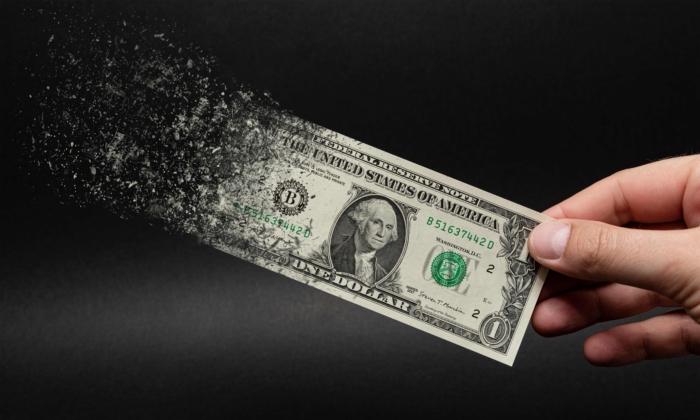Then again, that’s about all she wrote. At the current runoff rate of excess household cash, the historic 60 percent to GDP ratio will be reached by the end of 2024. At that point, the U.S. economy will be freighted down with more than $100 trillion of combined public and private debt. And it will not be characterized as either strong or even resilient.

Friday’s Jobs Report for April provides further reinforcement. In fact, the 175,000 gain in the headline jobs number represented the action of an economy that is living on borrowed time per the above-described cash cushion, and made to look even healthier by the purely bogus topline of the Bureau of Labor Statistics (BLS) establishment survey.
Growth Rate of Aggregate Private Sector Labor Hours:
• January 1964 to September 2000: +2.00 percent per annum.• September 2000 to April 2024: +0.74 percent per annum.
But that is from the so-called “establishment survey.” The latter is based on “mail-in” ballots from about 119,000 U.S. businesses or about 2.0 percent of the nation’s 6.1 million total business units that have at least one paid employee. At the present time, however, the response rate to the BLS survey is barely 43 percent compared to 63 percent as recently as 2014. Moreover, there is no special reason to believe that the missing 68,000 responses are random or consistent with the mix of firms actually mailing in their results in prior months, quarters, and years.
That doesn’t slow down the green eyeshades at the BLS, of course. The numbers for all the missing respondents and the rest of the full business economy are trended in, guesstimated, imputed, modeled in, birth/death adjusted, seasonally manipulated, and otherwise puked up out of the BLS’ goal-seeked computers. And then on Jobs Friday once per month, trillions of dollars’ worth of capital markets securities’ value moves up or down instantly and often materially on their publication.
Never mind that everything below the BLS report’s headline jobs number warns of disconnects, inconsistencies, puzzles, contradictions, and unreliability. For instance, today’s companion “household “survey, which is based on 50,000 phone interviews, as opposed to mail-in reports, indicated a job gain of just 25,000.
According to the BLS, here are the levels and the change between June 2023 and April 2024 for these two household survey categories:
We’d say go figure or, better yet, throw a dart at the BLS report and go with the number it lands on—since nearly all of them are badly massaged and incessantly revised.
To be clear, our point here is not to give the BLS a C- for its desultory efforts at job counting. To the contrary, it’s to give the Federal Reserve an F for even presuming that it can fiddle America’s $28 trillion economy between full employment and inflation on a month-to-month and even day-to-day basis via massive open market operations on Wall Street.
The whole misguided effort at monetary central planning has been an abject failure in part because the U.S. economy—integrally intertwined in the $105 trillion global economy—is too complex, fast-moving, opaque, and ultimately mysterious to be stage-managed by the 12 mere mortals who sit on the Fed’s Open Market Committee, and who on a daily basis command the movements of tens of trillions of securities and derivative financial instruments.
Back in the day, Hayek referred to this as the problem of socialist calculation, and it has not gone away simply because Gosplan-style socialism has been supplanted by central bank-based financial command and control.
Moreover, even if the information and calculation problem were somehow to be overcome by wiring the brains of every consumer, workers, business manager, entrepreneur, investor, saver, and speculator to a 10,000-acre farm of Cray Computers, the insuperable difficulties of the Fed’s self-assigned mission of plenary economic control would not be remotely overcome. That’s because rate cuts and interest rate suppression long ago lost their potency in an economy now saddled with $98 trillion of public and private debt.
In any event, the proof is actually in the pudding from April’s jobs report. As detailed above, between 1964 and the dotcom peak in 2000—and at a time before money-printing really went off the deep end—the BLS’ reasonably serviceable metric for total hours worked in the private economy had grown by about 2.0 percent per annum. Add another 2.0 percent per year for productivity improvement due to robust investment, technology progress, and the equipping of workers with more and better tools and production processes, and you had a 4 percent growth economy.
Obviously, no more. The Fed’s massive inflation of financial assets has caused a drastic diversion of capital into speculation on Wall Street rather than productive investment on Main Street. So productivity growth has faltered badly to just 1.25 percent per annum since 2010.
At the same time, the inflation-saturated U.S. economy has lost much of its industrial base to lower-cost venues abroad. Consequently, since the pre-dotcom peak in 2000, the growth rate of private sector labor hours employed has plunged to the aforementioned 0.74 percent per annum. Thus, the ingredients of economic growth added together now amount to just 2.0 percent or half the historic rate.
At the end of the day, there is no doubt about it. Both productivity growth and labor growth have been systematically undermined and diminished by the kind of Keynesian monetary central planning currently pursued by the Federal Reserve. And the current inching toward a new round of destructive money-printing is just further proof of that truism.
Nevertheless, the failure of monetary central planning has not diminished the harm being imposed on Main Street America by Fed policies. For instance, during the most recent month (January) U.S. home prices were up by 6.0 percent on a Y/Y basis and were therefore just one more reminder of why the Fed’s pro-inflation policies are so insidious. In essence, they set up a running battle between asset prices and wages, and the former wins hands down.
For avoidance of doubt, here is the long view on the matter, with home prices indexed in purple and average wages in black.

We have indexed the median sales price of homes in America and the average hourly wage to their values as of Q1 1970. That was the eve of Nixon’s plunge into pure fiat money at Camp David in August 1971 and all the resulting monetary excesses and metastases since then.
We have indexed the median sales price of homes in America and the average hourly wage to their values as of Q1 1970. That was the eve of Nixon’s plunge into pure fiat money at Camp David in August 1971 and all the resulting monetary excesses and metastases since then.
So the question recurs. Why in the world would our esteemed central bankers wish to impoverish America’s workers by doubling the working hours needed to buy a median priced home? And, yes, the above assault on the middle class is a monetary phenomenon. It was not caused by home builders monopolizing the price of new houses nor by shortages of land, lumber, paint, or construction labor over that half-century period.
To the contrary, when the Fed inflates the monetary system, the resulting ill effects work through the financial markets and real economy unevenly. Prices, including those for labor and assets, do not move in lockstep, because foreign competition holds down some prices and wages while falling real interest rates and higher valuation multiples inherently cause asset prices to rise disproportionately.
Thus, the reference rate for all asset prices—the 10-year U.S. Treasury note (UST)—fell drastically in real terms during the last four decades of that period. Real rates at 5 percent+ during the 1980s fell to the 2–5 percent range during the Greenspan era, and then plunged further, to zero or below, owing to the even more egregious money-printing policies of his successors.

The stated purpose of the easy-money trend depicted above, of course, was to spur more investment in housing, among other sectors. But that didn’t happen. The residential housing investment-to-GDP ratio dropped from the historical 5–6 percent zone prior in 1965 to an average of 4.5 percent during the period of the Greenspan housing bubble peak in 2005. After the housing crash during the Great Financial Crisis it barely posted at 3 percent of GDP before rebounding irregularly to 3.9 percent in 2023.
Any way you slice it, however, the aggressive monetary expansion after 1987 did not spur incremental housing investment on any sustainable basis. Instead, it led to debt-fueled speculation in the existing housing stock, sending prices rising far faster and far higher than the growth of household income and wages.

An alternative measure of the impact of easy money on housing investment can be seen in the index of housing completions relative to the U.S. population. Since the early 1970s, that ratio has been trending steadily downward and now stands at only 45 percent of its 50-years-ago value.

Needless to say, if cheap mortgage credit were the elixir it is claimed to be, the line in the chart would have trended skyward. As it happened, however, it is a stinging repudiation of the very essence of the case for low interest rates so relentlessly promoted by Wall Street and Washington alike.
At the end of the day, the U.S. economy is not remotely “strong,” as the talking heads blathered about again on Friday, May 3. Likewise, the BLS report is once again hardly worth the digital ink it is printed upon.
So, a central bank policy based on a monetary politburo fiddling the nation’s massive $28 trillion economy toward undefinable and immeasurable full employment and 2.00 percent inflation can be described in only one way. To wit, a trainwreck in full flight.




